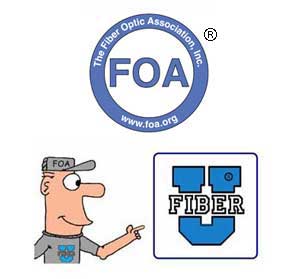Fiber
Optics For Wireless Networks
Includes Fiber Optics And Cabling As Used In These
Networks:
Cellular
Cell
sites
Fiber to the Antenna (FTTA)
Small Cells
Distributed Antenna Systems (DAS)
WiFi
Enterprise/Premises
Metro
Rural
Intended
For:
Anyone
new to how fiber optics is used in wireless systems who
wants to learn how they work
Designers
and installers involved
in wireless projects with fiber optic cabling
Managers
and supervisors involved in wireless projects
May
be used as preparation for the FOA CFOS/W
Exam which covers the same basic material in this
course
Objectives:
From this self-study program you should learn:
The
technology and architecture of wireless networks
How
cabling connects all elements of a distributed
antenna systems
What
types of cabling (copper or fiber) are used in wireless
networks
Issues
in designing and installing fiber
optic cabling.
- Prerequisites

When
you finish, you can take an online exam on this course to
qualify for a "Fiber U Certificate of Completion."
Introduction
Wireless
traffic is growing at a phenomenal rate. AT&T says
their cellular data traffic has grown >80,000%
(that's >800 times) between 2007 (the introduction
of the iPhone) and today. The landscape is covered
with cellular towers but the majority of cellular
connections (70-80% for both voice or data) originate
inside buildings, so wireless coverage inside
buildings has become more important. Cellular wireless
signals often cannot penetrate walls and even windows
in large buildings, requiring low-power cellular
antennas placed inside buildings to provide reliable
service. The technology developed for these low power
distributed antenna systems (DAS) inside buildings has
been expanded to similar low-power sites outdoors on
street light poles, traffic signals, utility poles,
buildings, etc.called small cells. These small cells
are being developed as 4G cellular technology but are
a cornerstone of 5G planning.

The 49ers stadium has over 700 cellular antennas as
part of its DAS
There are other reasons for cellular systems inside
buildings or structures. Sometimes the number of users
inside a building like a convention center or sports
facility exceeds the bandwidth of a single cellular
system. In many areas, local laws specify the need for
public safety radio signal coverage (fire, police,
emergency) inside every building that requires indoor
antenna coverage.
Auto or mass transit tunnels are also obvious
applications for cellular distributed antenna systems.
Small cells are being built to accommodate the higher
data usage of the smartphone and tablet users
primarily in an urban environment. These cellular
customers are now watching video on their portable
devices, causing a similar problem to users streaming
video on the wired Internet - video requires many
times more bandwidth than web browsing, email or
texting. Only by both reducing the number of users per
site and increasing the bandwidth can this kind of
traffic be accommodated. To indicate the size of the
problem, several football stadiums with about 1000 DAS
antennas have reported that the attendees during a
game downloaded and uploaded over 3 terabytes of data
during a game.
WiFi has been a staple of the Ethernet LAN for
business and home for many years. The speed has
increased to a point that customer devices like
laptops no longer have wired Ethernet ports. Now you
can use WiFi indoors on many cell phones if cellular
signal is poor or unavailable. Designing a LAN cabling
system now requires designing a backbone cabling
system, a few drops to wired users like engineering or
graphics users and careful site selection for WiFi
access points for maximum coverage for everyone else.
WiFi has migrated from coffee shops and restaurants to
outdoors in many metropolitan areas. Some line of sight
WiFi is used in metro areas where it is too difficult or
expensive to install fiber optic cabling. In rural areas,
sometimes the only connections to the Internet are
using line of sight WiFi.
In this course, you will learn about all these
applications and more.
Assignments
For
each lesson plan you will be instructed to read the
references or watch videos and take the quiz (Test Your
Knowledge) to complete the "classroom" part of the course.
Lesson
Plans
Read
the materials or watch the videos linked on each lesson
plan and take the quiz.
Lesson 1Introduction:
- How Wireless Networks Use Fiber Optics
Lesson 2: Fiber
To The Cell Site And
Fiber To The Antenna
Lesson 3:
Distributed Antenna Systems (DAS)
Lesson 4:
Small Cells
Lesson 5: WiFi -
Enterprise, Urban and Rural

When
you finish all the assignments and case study, you can
take an online exam on this course to qualify for a "Fiber
U Certificate of Completion." The exam cost is $20US.
Go
here to take the Fiber U "Fiber For Wireless"
Certificate of Completion exam. Here
are detail directions if this is your first time
taking a Fiber
U Certificate of Completion exam.
This information is
provided by The Fiber Optic Association, Inc. as a
benefit to those interested in teaching, designing,
manufacturing, selling, installing or using fiber optic
communications systems or networks. It is intended to be
used as an overview and/or basic guidelines and in no
way should be considered to be complete or
comprehensive. These guidelines are strictly the opinion
of the FOA and the reader is expected to use them as a
basis for learning, as a reference and for creating
their own documentation, project specifications, etc.
Those working with fiber optics in the classroom,
laboratory or field should follow all safety rules
carefully. The FOA assumes no liability for the use of
any of this material.
|



